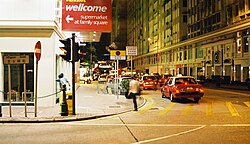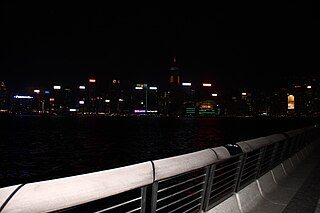
Wan Chai District is one of the 18 districts of Hong Kong. Of the four on Hong Kong Island, it is north-central, and had 166,695 residents in 2021, an increase from 152,608 residents in 2011. The district has the second-highest educationally qualified residents with the highest-bracket incomes, the second-lowest population and the third-oldest quotient. It is a relatively affluent district, with one in five persons having liquid assets of more than HKD 1 million.
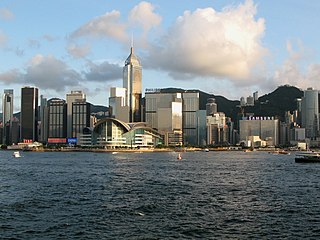
Wan Chai is situated at the western part of Wan Chai District on the northern shore of Hong Kong Island, in Hong Kong. Its other boundaries are Canal Road to the east, Arsenal Street to the west and Bowen Road to the south. The area north of Gloucester Road is often referred to as Wan Chai North.

Hong Kong Island is an island in the southern part of Hong Kong. The island, known originally and on road signs simply as "Hong Kong", had a population of 1,289,500 and a population density of 16,390 per square kilometre (42,400/sq mi), as of 2008. The island had a population of about 3,000 inhabitants scattered in a dozen fishing villages when it was occupied by the United Kingdom in the First Opium War (1839–1842). In 1842, the island was formally ceded in perpetuity to the UK under the Treaty of Nanking and the City of Victoria was then established on the island by the British Force in honour of Queen Victoria. The Central area on the island is the historical, political and economic centre of Hong Kong. The northern coast of the island forms the southern shore of the Victoria Harbour, which is largely responsible for the development of Hong Kong due to its deep waters favoured by large trade ships.
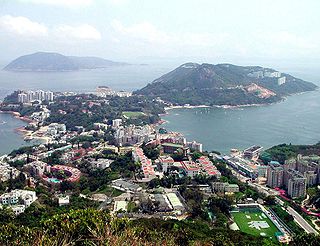
Stanley, or Chek Chue, is a coastal town and a popular tourist attraction in Hong Kong. It is located on a peninsula on Hong Kong Island. It is east of Repulse Bay and west of Shek O, adjacent to Chung Hom Kok and Tai Tam. Administratively, it is part of the Southern District.
Hong Kong counts approximately 600 temples, shrines and monasteries. While Buddhism and Christianity are the most widely practiced religions, most religions are represented in the Special Administrative Region.

Shau Kei Wan or Shaukiwan is a neighborhood in the Eastern District of Hong Kong Island. The area is bordered by Chai Wan to the east, Mount Parker to the south, Sai Wan Ho to the west, and Victoria Harbour to the north.
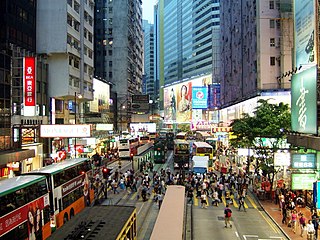
East Point was a spit on the northern shore of Hong Kong Island, Hong Kong. It extended from East Point Hill, i.e. Lee Garden towards Kellett Island and marked the eastern limits of the early City of Victoria. The piece of land separated Causeway Bay in the east and Wong Nai Chung in the west. Streams and muds from Tai Hang and Wong Nai Chung shaped the spit.

Causeway Bay is an underground metro station on the MTR network in Hong Kong. It is located between Wan Chai and Tin Hau stations on the Island line, and sits underneath Great George Street near Hennessy Road and Yee Wo Street. Named for the Causeway Bay area and its abundant shopping centres, the station serves various malls including Hysan Place, Sino Plaza, Sogo, and the nearby Victoria Park.

Tamar is a station on MTR's shelved North Island line (NIL) proposal on the north shore of Hong Kong Island. It will be located on the former site of HMS Tamar on Hong Kong Island, Hong Kong. Tamar station will be the eastern terminus of the Tung Chung line and the western terminus of the Tseung Kwan O line. It will also act as a transfer station between the two lines.

Gloucester Road is a major highway in Hong Kong. It is one of the few major roads in Hong Kong with service roads. It was named on 14 June 1929 after Prince Henry, Duke of Gloucester, to commemorate his visit to Hong Kong that year. The road is 2.2 kilometres in length and has a speed limit of 70 km/h.

Braemar Hill is a hill with a height of 200 metres (660 ft) south of Braemar Point on Hong Kong Island, Hong Kong. The hill was likely named after the Scottish village of Braemar by British officials.

Causeway Road is a main road in Hong Kong. Situated in Causeway Bay, it joins Yee Wo Street in the west and King's Road. It is a boundary of Eastern District and Wan Chai District. North side of the road is Victoria Park in Eastern District while in the Wan Chai District in the south are Queen's College and Hong Kong Central Library.
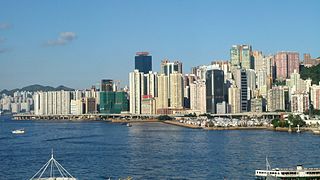
Tin Hau is an area in Wan Chai District, on the north side of Hong Kong Island, in Hong Kong.
Articles related to Hong Kong include:

Tin Hau temples in Hong Kong are dedicated to Tin Hau (Mazu). Over 100 temples are dedicated to Tin Hau in Hong Kong. A list of these temples can be found below.

The Tin Hau Temple in Causeway Bay is one of the Tin Hau temples in Hong Kong. It is located at 10 Tin Hau Temple Road, Causeway Bay, east of Victoria Park, in Eastern District, on Hong Kong Island. The temple has given its name to the MTR station serving it, and consequently the neighboring area of Tin Hau.

Metropark Hotel Causeway Bay Hong Kong was a four-star Hotel in Causeway Bay, Wan Chai District, Hong Kong. It was located on 148 Tung Lo Wan Road. The hotel was close to Tin Hau station with 33 floors and 266 rooms. The hotel opened in 2002 and was owned by China Travel Service.







